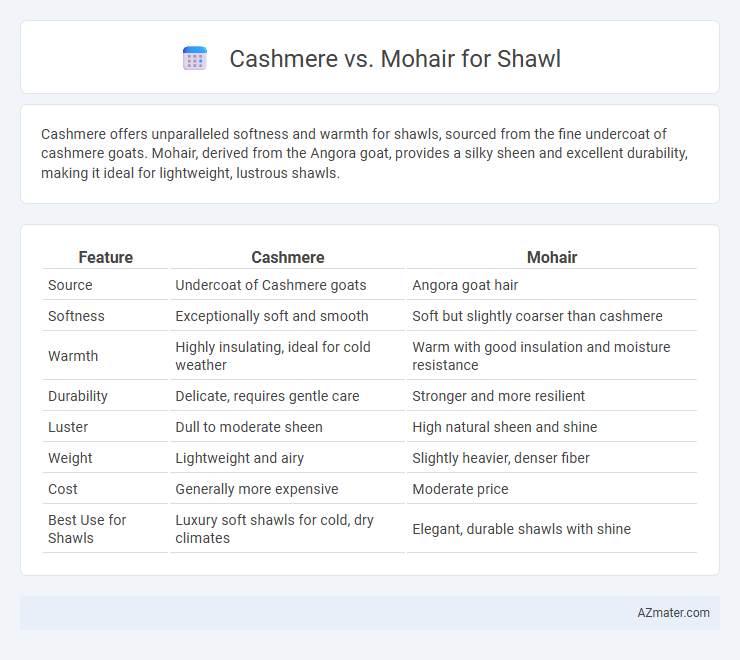Cashmere offers unparalleled softness and warmth for shawls, sourced from the fine undercoat of cashmere goats. Mohair, derived from the Angora goat, provides a silky sheen and excellent durability, making it ideal for lightweight, lustrous shawls.
Table of Comparison
| Feature | Cashmere | Mohair |
|---|---|---|
| Source | Undercoat of Cashmere goats | Angora goat hair |
| Softness | Exceptionally soft and smooth | Soft but slightly coarser than cashmere |
| Warmth | Highly insulating, ideal for cold weather | Warm with good insulation and moisture resistance |
| Durability | Delicate, requires gentle care | Stronger and more resilient |
| Luster | Dull to moderate sheen | High natural sheen and shine |
| Weight | Lightweight and airy | Slightly heavier, denser fiber |
| Cost | Generally more expensive | Moderate price |
| Best Use for Shawls | Luxury soft shawls for cold, dry climates | Elegant, durable shawls with shine |
Introduction to Cashmere and Mohair
Cashmere comes from the undercoat of Cashmere goats and is renowned for its exceptional warmth, softness, and lightweight feel, making it a premium choice for shawls. Mohair, sourced from the Angora goat, is distinct for its silky texture, high sheen, and durability, offering enhanced resilience for long-lasting wear. Both fibers provide luxurious comfort, but Cashmere excels in softness while Mohair stands out for its luster and strength in shawl craftsmanship.
Origins and Production Processes
Cashmere originates from the undercoat of the Cashmere goat indigenous to Mongolia and the Himalayas, where fine fibers are hand-combed during the spring molting season. Mohair comes from the Angora goat, primarily raised in South Africa and Turkey, with fibers sheared twice annually to produce a smooth, lustrous texture. The labor-intensive harvesting of Cashmere leads to finer, softer shawls, while Mohair's durable and silky fibers result from a mechanical shearing process enhancing resilience in shawl production.
Softness and Texture Comparison
Cashmere shawls offer unparalleled softness due to the fine undercoat fibers of cashmere goats, creating a smooth, lightweight texture that feels luxurious against the skin. Mohair, sourced from the Angora goat, has a silkier, slightly coarser texture with a natural sheen, making it more durable but less soft than cashmere. Both fibers provide warmth and elegance, but cashmere is preferred for its exceptional softness, while mohair is chosen for its resilience and lustrous finish.
Warmth and Insulation Properties
Cashmere shawls provide superior warmth due to their fine, dense fibers that trap heat efficiently while remaining lightweight. Mohair shawls, derived from the Angora goat, offer excellent insulation with a silky texture and natural moisture-wicking properties that maintain warmth even in damp conditions. Both fibers excel in thermal retention, but cashmere generally delivers a softer feel and higher insulating value ideal for cold climates.
Durability and Longevity
Cashmere shawls offer exceptional softness but tend to be less durable than mohair, with fibers that can wear out faster under frequent use. Mohair, derived from the Angora goat, is known for its strength and resilience, providing longer-lasting durability in shawls even with regular wear. When choosing between cashmere and mohair for a shawl, mohair is the preferred option for longevity and maintaining structural integrity over time.
Breathability and Comfort
Cashmere offers exceptional breathability due to its fine fibers, allowing air circulation that keeps the wearer comfortable and warm without overheating. Mohair, derived from the Angora goat, provides a lightweight yet insulating quality with slightly less breathability but offers a silky smooth texture that enhances comfort. Both fibers excel in softness, but cashmere is generally preferred for breathability and moisture-wicking properties essential for shawls worn in variable climates.
Color and Dyeing Capabilities
Cashmere offers a rich, natural color palette typically in soft neutrals like beige, gray, and cream, which readily absorb dyes for vibrant, even coloration in shawls. Mohair fibers possess a inherent sheen and take dye exceptionally well, producing bright, lustrous colors that enhance the fabric's luxurious appearance. Both fibers provide excellent dye retention, but mohair's silk-like surface allows for more vivid and intense color finishes compared to the softer hues achievable with cashmere.
Price Point and Affordability
Cashmere shawls generally command higher prices due to the luxurious softness and rarity of cashmere fibers, often making them a premium investment. Mohair shawls, derived from the Angora goat, tend to be more affordable while still offering a silky texture and excellent durability. Price points typically range from $100 to $500 for cashmere, whereas mohair shawls often fall between $50 and $200, making mohair a budget-friendly alternative without sacrificing quality.
Care and Maintenance Tips
Cashmere shawls require gentle hand washing with mild detergent and air drying flat to maintain softness and prevent fiber damage, while mohair shawls benefit from dry cleaning or delicate hand washing with cold water to preserve their sheen and prevent felting. Both fabrics should be stored in breathable garment bags away from direct sunlight and moth-prone areas to extend longevity. Regularly brushing mohair with a soft-bristle brush helps maintain its fluffy texture whereas cashmere may require occasional pilling removal using a fabric shaver.
Choosing the Best Fiber for Your Shawl
Cashmere fibers are prized for their exceptional softness, warmth, and lightweight feel, making them ideal for luxurious shawls that provide comfort without bulk. Mohair, derived from the Angora goat, offers a distinct lustrous sheen, superior durability, and excellent insulation, often chosen for shawls requiring more structure and resilience. When choosing the best fiber for your shawl, consider cashmere for its delicate softness and warmth, while mohair is better suited for a vibrant, durable garment with a distinctive sheen.

Infographic: Cashmere vs Mohair for Shawl
 azmater.com
azmater.com